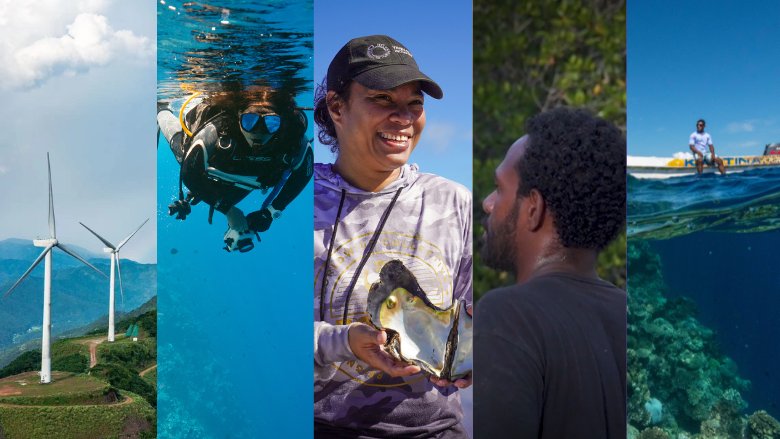Here are five examples.
Climate change is already having a profound impact on East Asia and the Pacific. This is a region that includes 13 of the 30 most climate-vulnerable countries on the planet, and which without concerted action could see millions more people fall into poverty due to climate impacts in the next few years.
In the face of such facts, it can be tough not to feel exhausted or a sense of despair. ‘Climate anxiety’ is very real.
Yet, there are plenty of reasons for hope, for optimism. Here are five of them.
1. The pathways to a more sustainable future are becoming better defined.
A series of important new reports – called Country Climate and Development Reports (CCDRs) – have been launched for China, Philippines and Vietnam, with more to come across East Asia and the Pacific – including Cambodia, Indonesia and Pacific atoll countries – in the coming months.
These reports provide a vital new resource for governments to map a path to a low-carbon future, and help identify opportunities for climate action – both mitigation, and adaptation – so that each country’s development goals can be achieved in the context of sustainability.
2. Women are leading the way.
Each March, we celebrate International Women’s Day, meeting extraordinary women doing remarkable things to address the biggest challenges in their country. And there’s arguably no greater challenge than the climate crisis.
China’s Ni Huan, Vietnam’s Hoang Thi Minh Hong, and Papua New Guinea’s Vinzealhar Ainjo Nen – each leaders of some of their countries’ most respected environmental NGOs – are doing their part to help us better understand the disproportionate impact of climate change on women. Read their stories.
3. Communities are adapting and thriving; even 5 meters below the surface.
While we often associate the climate crisis with impacts on land – drought, flooding, changing agricultural patterns and coastal erosion, for example – its impacts under the ocean’s surface are similarly profound.
Across the Pacific, a World Bank program is helping manage the impacts of a changing climate – increasingly severe cyclones impact coastal areas, rising sea levels, and warming ocean waters are leading entire deep-water fish populations to migrate outside their traditional areas.
Read more about the impact of the Pacific Regional Oceanscape Program (PROP), or dive further into uplifting stories from Marshall Islands, Kiribati and Tonga.
4. ‘Green development’ is no longer just a buzzword; communities are proving it.
As the world’s largest island state and the world’s fourth most populous country, Indonesia’s approach to addressing climate change will be one that many countries may follow. For example, East Kalimantan province just received its first payment of $21m from the Forest Carbon Partnership Facility in recognition for its efforts to reduce emissions and protect forests.
And Jambi Province, central Sumatra, in Indonesia ’s west, is now on a path that could see it become a genuine role model of sustainable landscapes in Indonesia and beyond. Through partnerships between provincial governments, NGOs and communities, forests are being better protected, a moratorium on oil palm plantation licenses is in place, and green growth plans that map out sustainable pathways for communities are now in place. In short, Jambi is setting a standard that others are now looking towards.
In Jambi’s Merangin district, for instance, a 400,000-hectare geo-park is now being established – to protect and promote the area’s rich treasure of fauna and flora fossils, while promoting nature-based tourism in the mountainous areas. A Master Plan and management body are now in place, UNESCO recognition is being sought, and the destination is now being actively marketed to international tourists as Indonesia’s ‘Hidden Paradise’. The district has also championed recognition of customary communities’ land and forestry titles, with communities being supported to turn their backs on logging and palm oil; instead earning incomes through other sustainable forest products, such as honey and cinnamon.
5. Resilience is not only a good idea; it’s a smart investment.
2022 has seen record levels of commitments from the World Bank, and many other partners critical to tackling the climate crisis. In line with the World Bank Group’s Climate Change Action Plan (2021-2025), in East Asia and the Pacific, 46% of new World Bank commitments in fiscal year 2022 contributed to climate action.
This includes new projects a across the region, from the largest to the smallest and most climate-vulnerable countries – such as US$700 million in combined commitments to help address water scarcity and ecosystem degradation in China’s Yellow River basin and promote green agriculture in the country’s southwest; to adaptation projects to protect many of Kiribati’s most isolated island communities, and a climate-resilient upgrade of harbors across Tuvalu.
As these efforts pick up pace, and successful approaches are refined and replicated across countries, we can expect more reasons to hope to emerge out of the climate fight in East Asia and the Pacific.

